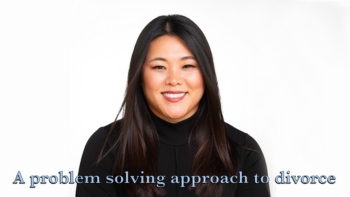The Illinois Supreme Court Rules that the “Equitable Adoption” and “Functional Parent” Theories Cannot be Raised By a Nonparent Seeking Custody of a Child
Michele Jochner
This past week, the Illinois Supreme Court delivered its long-awaited answer to a question which has been debated in the family law community for some time: does the doctrine of “equitable adoption” – first recognized by our Supreme Court in its 2013 decision in DeHart v. DeHart, 2013 IL 114137 – also apply in the context of child custody actions? In In re Parentage of Scarlett Z. – D., 2015 IL 117904, the Court firmly closed the door on a nonparent raising an equitable adoption argument in a custody case by limiting its application to “the context of inheritance.” Further, the Court similarly foreclosed arguments that a “functional parent-child relationship” provides a nonparent with standing to seek custody of a child.
It has been nearly two years since the Illinois Supreme Court broke new ground by recognizing the “equitable adoption” doctrine for the first time. This doctrine allows a person who was accepted and treated as a natural or adopted child, and as to whom adoption was promised or contemplated but never legally achieved, to share in the inheritance of the promisor.
A brief review of the facts in the DeHart case reveals the legal and policy principles animating this doctrine. James DeHart brought an action against the executor of the estate of decedent Donald DeHart to contest Donald’s will. Donald had married James’ birth mother when James was about two years old, and agreed to adopt James, although the adoption would be kept secret “for the good of the family.” Instead, Donald held James out to be his biological son for his entire life. To achieve the adoption, Donald hired an attorney and received a purported birth certificate that named him as James’ father, a document upon which the family relied – as the Court put it – “to conduct the affairs of life.” It was not until James was 56 that he obtained his true birth certificate, and first learned that he was not Donald’s biological son. Although there was no documentation that a legal adoption had ever occurred, Donald continued to hold James out as his son and executed a will leaving him an inheritance. In the interim, James’ mother died, and Donald – at the age of 83 – married a woman 30 years his junior who allegedly exerted undue influence over him in causing his execution of a will stating he had no children and in which he left nothing to James.
When Donald died, the executor of his estate (Donald’s second wife) filed the second will with the court. James contested that will on a number of grounds, including that an equitable adoption had occurred and that Donald’s estate was therefore estopped from denying that James was an heir. The Illinois Supreme Court agreed with James and held that “in Illinois an equitable adoption theory should be recognized under the right circumstances.” Clearly, our Supreme Court believed that the situation presented in DeHart squarely fit this bill.
After DeHart, questions arose as to the scope of the Court’s ruling, and whether the “right circumstances” included expansion of the application of the equitable adoption theory to a child custody situation. The Supreme Court addressed and rejected this argument in Scarlett Z.-D.
In that case, Maria and Jim began living together in 1999 and shortly thereafter became engaged to be married. Maria then took a trip to Slovakia in 2003 to visit family, and she met Scarlett, who was a 3 ½-year-old orphan. Although the couple decided they wanted Scarlett to be part of their lives, Slovakian law prevented Jim from adopting her because he was neither a Slovakian national nor married to Maria. Thus, it was Maria who undertook a year-long process to adopt the child and she lived in Slovakia during that time. Jim, however, financially supported the process, traveled there five times, and participated in a psychological evaluation. In 2004, Maria adopted Scarlett under Slovakian law, and the three returned to Elmhurst, where Scarlett used the hyphenated form of Jim and Maria’s last names and referred to Jim as “daddy.” Jim’s name also appeared in Scarlett’s school records as her father, he paid all family expenses, and he established a $500,000 irrevocable trust for her. However, in 2008, Maria moved out of Jim’s home, taking Scarlett with her.
Jim filed an action in the Circuit Court of DuPage County, seeking a declaration of parentage, custody, visitation and child support as to Scarlett, based on several arguments, including a “functional parent” theory. Maria moved to dismiss Jim’s action on the basis that he lacked standing as a nonparent. The circuit court either dismissed or denied Jim’s claims, and that judgment was affirmed by the Appellate Court. Jim appealed to the Illinois Supreme Court, which used its supervisory authority to direct the Appellate Court to vacate its decision and reconsider the case in light of its then-recently-decided opinion in DeHart. A divided panel of the Appellate Court affirmed the rejection of Jim’s functional parent theories, but remanded the action for additional fact-finding to determine whether the doctrine of equitable adoption as first recognized in DeHart could apply. Maria then appealed to the Supreme Court.
The Illinois Supreme Court made it crystal-clear that the doctrine of equitable adoption, previously recognized in a will contest, does not apply to child custody proceedings. The Court clarified that the doctrine “is a probate concept to determine inheritance and does not apply to proceedings for parentage, custody and visitation.” As further support for this limitation, the Court underscored that this doctrine is merely an equitable remedy and “not intended or applied to create the legal relationship of parent and child, with all the legal consequences of such a relationship, nor is it meant to create a legal adoption.”
The Court also put the brakes on any further arguments based on a “functional parent” theory. Although Jim had conceded that he lacked statutory standing to commence a custody proceeding, he claimed he could gain standing in equity because he had a “functional parent-child relationship” with Scarlett, which had two aspects: a “psychological” or “de facto” parent relationship involving deep emotional bonds such that the child recognized him as a parent from whom she received daily nurture and guidance, as well as an in loco parentis relationship whereby Jim intentionally placed himself in a parental status. Although the Court engaged in a lengthy discussion regarding these novel theories, it concluded that because they involved fundamental matters of public policy, “legislative and not judicial solutions are preferable.”



